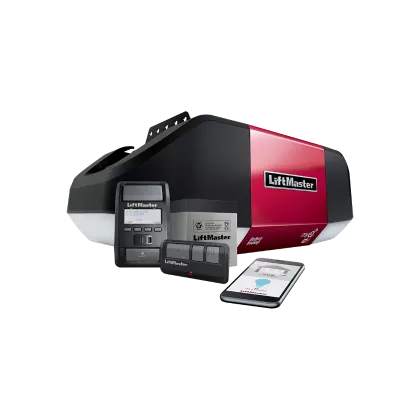When it comes time for a new garage door opener, finding the best one can be a bit challenging. Ultimately, it’s about getting what you need. If that’s a belt‑drive opener, there are a lot of benefits to be had. Of course, there are a few different types of electric garage door opener drives to choose from:
-
Chain drive (think of a bicycle chain)
-
Belt drive (using a steel‑reinforced rubber belt)
-
Screw drive (much less common in cold regions)
-
Jackshaft opener (wall‑mounted opener)
Although these openers all have their place, there are some applications where a belt drive will simply be the best option. Keep reading to find out why this style is so popular.

But first, let’s discuss motors
Who knew there were so many details involved in selecting the right garage door opener? Fortunately, motors are pretty simple to understand. There are only two choices for your garage door: AC or DC power. Direct Current (DC) motors have a variable operating speed. That is, they start slowly, speed up, and then slow down before stopping. An AC, or Alternating Current, motor operates at a single speed throughout the cycle. Both have a rate of around 6‑8 inches per second, which varies by model.
Does the motor type matter? In some cases, it does. For example, if you want a quieter motor, the DC motor is your better option. DC motors are also compatible with backup battery power supplies, which cannot be used with AC motor types.
How do belt drives work?
A belt‑drive opener has a central trolley system, which is typically installed on the ceiling in the middle of the garage (or centered on the door). Much like car tires, the belt that operates the system is a rubber composite that is reinforced with steel. Some belts are also made with polyurethane and fiberglass components.
The belt forms a lop along a t‑shaped track that is installed on the garage ceiling. The belt has adjustable tension for proper operation and can be used with a ½ or ¾ horsepower motor, depending on your garage door size.
Remember, your opener is just supposed to replace the lifting strength it would require to handle the door manually. Therefore, your door needs to be properly balanced at all times. It should feel like it weighs around 8‑10 pounds, or 3.5‑4 kilos. You should be able to easily lift the door with a single hand. If not, there is a major problem with your door system.
The perks of belt‑drive openers
The reason that this system is popular is largely due to the fact that it offers a much quieter operation than other styles. In fact, these systems are as much as 25‑30% quieter than chain drive openers. Especially in homes with living areas or bedrooms above the garage, a belt drive style is often the best choice. Plus, you can even choose a style like the 8550W from LiftMaster, which will come with a DC motor for ultra‑quiet operation and optional battery backup.

Of course, you can’t just choose any belt drive. It takes more than a belt to make a good garage door opener, after all. You have to consider the housing construction and the track installation, which could affect the noise and efficient operation of the opener.
The belt drive does have many perks, but it has one element holding it back from some homes: the cost. This type of opener can cost much more than a chain‑drive system, which can even be purchased in a big box store if saving money is more important than quality operation. Is it worth the money? For the noise reduction alone, it is worth every penny.
Other ways to reduce noise coming from your garage door
-
Secure your opener: If your motor housing is installed on ceiling joists or another unstable surface, you can use semi‑rigid rubber strips to reduce noise. You can also buy a specific vibration isolation kit that will help reduce vibration noise.
-
Lubricate metal parts regularly: Twice per year, at the least, you should use motor oil, such as 5W30 oil, to lubricate all of the metal parts on the door. Do not lubricate the belt drives or the opener system itself. Those were taken care of by your installation technician and won’t need attention for 5‑7 years. You should lubricate the tracks, hinges, rollers, and springs.
-
Choose nylon rollers instead of metal ones: While some people might think they are fine with metal rollers, nylon rollers are much quieter and more efficient. They also come in black and white.
-
Install the Jackshaft system: If you have space beside the door install this opener instead, for a more secure installation that will reduce noise transmission.
-
Get rid of your wood floors: If there is a bedroom over the garage and it has wood floors, consider installing carpet or putting down an area rug to dampen the noise transmission.
There is no one guaranteed way to reduce the noise made by your garage door. Usually, it is a combination of efforts that produce the best result. Contact a qualified technician at Overhead Door NFLD for assistance.
Ok, how can you help?
Give us a call at 709‑368‑7222. We are experts at all things garage door related, including opener systems. We know the best brands on the market and can help you find what you need. When you contact us, we can also offer a private email quotation.


Add new comment